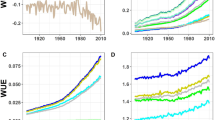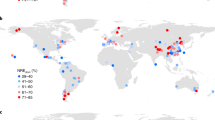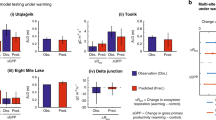Abstract
Terrestrial carbon–climate feedbacks depend on two large and opposing fluxes—soil organic matter decomposition and photosynthesis—that are tightly regulated by nutrients1,2. Earth system models (ESMs) participating in the Coupled Model Intercomparison Project Phase 5 represented nutrient dynamics poorly1,3, rendering predictions of twenty-first century carbon–climate feedbacks highly uncertain. Here, we use a new land model to quantify the effects of observed plant nutrient uptake mechanisms missing in most other ESMs. In particular, we estimate the global role of root nutrient competition with microbes and abiotic processes during periods without photosynthesis. Nitrogen and phosphorus uptake during these periods account for 45 and 43%, respectively, of annual uptake, with large latitudinal variation. Globally, night-time nutrient uptake dominates this signal. Simulations show that ignoring this plant uptake, as is done when applying an instantaneous relative demand approach, leads to large positive biases in annual nitrogen leaching (96%) and N2O emissions (44%). This N2O emission bias has a GWP equivalent of ~2.4 PgCO2 yr−1, which is substantial compared to the current terrestrial CO2 sink. Such large biases will lead to predictions of overly open terrestrial nutrient cycles and lower carbon sequestration capacity. Both factors imply over-prediction of positive terrestrial feedbacks with climate in current ESMs.
This is a preview of subscription content, access via your institution
Access options
Access Nature and 54 other Nature Portfolio journals
Get Nature+, our best-value online-access subscription
$29.99 / 30 days
cancel any time
Subscribe to this journal
Receive 12 print issues and online access
$209.00 per year
only $17.42 per issue
Buy this article
- Purchase on Springer Link
- Instant access to full article PDF
Prices may be subject to local taxes which are calculated during checkout



Similar content being viewed by others
Data availabilty
The data that support the findings of this study are available from the corresponding author upon request.
References
Zaehle, S. et al. Evaluation of 11 terrestrial carbon–nitrogen cycle models against observations from two temperate free-air CO2 enrichment studies. New Phytol. 202, 803–822 (2014).
Wang, Y. P., Law, R. M. & Pak, B. A global model of carbon, nitrogen and phosphorus cycles for the terrestrial biosphere. Biogeosciences 7, 2261–2282 (2010).
Ghimire, B., Riley, W. J., Koven, C. D., Mu, M. & Randerson, J. T. Representing leaf and root physiological traits in CLM improves global carbon and nitrogen cycling predictions. J. Adv. Model. Earth Syst. 8, 598–613 (2016).
Hungate, B. A., Dukes, J. S., Shaw, M. R., Luo, Y. Q. & Field, C. B. Nitrogen and climate change. Science 302, 1512–1513 (2003).
Wieder, W. R., Cleveland, C. C., Smith, W. K. & Todd-Brown, K. Future productivity and carbon storage limited by terrestrial nutrient availability. Nat. Geosci. 8, 441–444 (2015).
Luo, Y. et al. Progressive nitrogen limitation of ecosystem responses to rising atmospheric carbon dioxide. Bioscience 54, 731–739 (2004).
LeBauer, D. S. & Treseder, K. K. Nitrogen limitation of net primary productivity in terrestrial ecosystems is globally distributed. Ecology 89, 371–379 (2008).
Elser, J. J. et al. Global analysis of nitrogen and phosphorus limitation of primary producers in freshwater, marine and terrestrial ecosystems. Ecol. Lett. 10, 1135–1142 (2007).
Zhu, Q., Riley, W. J. & Tang, J. Y. A new theory of plant and microbe nutrient competition resolves inconsistencies between observations and models. Ecol. Appl. 27, 875–886 (2017).
Zaehle, S. & Friend, A. D. Carbon and nitrogen cycle dynamics in the O-CN land surface model: 1. Model description, site-scale evaluation, and sensitivity to parameter estimates. Glob. Biogeochem. Cycles 24, GB1005 (2010).
Albornoz, F. & Lieth, J. H. Diurnal macronutrients uptake patterns by lettuce roots under various light and temperature levels. J. Plant. Nutr. 38, 2028–2043 (2015).
Schimel, J. P., Jackson, L. E. & Firestone, M. K. Spatial and temporal effects on plant–microbial competition for inorganic nitrogen in a California annual grassland. Soil Biol. Biochem. 21, 1059–1066 (1989).
Hansen, G. K. Diurnal-variation of root respiration rates and nitrate uptake as influenced by nitrogen supply. Physiol. Plant. 48, 421–427 (1980).
Lejay, L. et al. Molecular and functional regulation of two NO3 − uptake systems by N- and C-status of Arabidopsis plants. Plant J. 18, 509–519 (1999).
Okuyama, Y., Ozawa, K. & Takagaki, M. Diurnal changes in nitrogen and potassium absorption rates of plants grown in a greenhouse. J. Agric. Meteorol. 71, 256–262 (2015).
Andresen, L. C. & Michelsen, A. Off-season uptake of nitrogen in temperate heath vegetation. Oecologia. 144, 585–597 (2005).
Weih, M. Growth of mountain birch seedlings in early-successional patches: a year-round perspective. Plant Biol. 2, 428–436 (2000).
Chapin, F. S. & Bloom, A. Phosphate absorption—adaptation of tundra graminoids to a low-temperature, low phosphorus environment. Oikos 27, 111–121 (1976).
Delhon, P., Gojon, A., Tillard, P. & Passama, L. Diurnal regulation of NO3 − uptake in soybean plants. 1. Changes in NO3 − influx, efflux, and N utilization in the plant during the day/night cycle. J. Exp. Bot. 46, 1585–1594 (1995).
Tang, J. Y. & Riley, W. J. A total quasi-steady-state formulation of substrate uptake kinetics in complex networks and an example application to microbial litter decomposition. Biogeosciences 10, 8329–8351 (2013).
Zhu, Q., Riley, W. J., Tang, J. Y. & Koven, C. D. Multiple soil nutrient competition between plants, microbes, and mineral surfaces: model development, parameterization, and example applications in several tropical forests. Biogeosciences 13, 341–363 (2016).
Zhu, Q., Iversen, C. M., Riley, W. J., Slette, I. & Vander Stel, H. Root traits explain observed tundra vegetation nitrogen uptake patterns: implications for trait-based land models. J. Geophys. Res. Biogeosci. 121, 3101–3112 (2016).
Zhu, Q. & Riley, W. J. Improved modeling of soil nitrogen losses. Nat. Clim. Change 5, 705–706 (2015).
Wu, Z. D. et al. Climate data induced uncertainty in model-based estimations of terrestrial primary productivity. Environ. Res. Lett. 12, 064013 (2017).
Myhre, G. et al. in Climate Change 2013: The Physical Science Basis (eds Stocker, T. F. et al.) 658–740 (IPCC, Cambridge Univ. Press, 2013).
Tang, J. Y. & Riley, W. J. Predicted land carbon dynamics are strongly dependent on the numerical coupling of nitrogen mobilizing and immobilizing processes: a demonstration with the E3SM land model. Earth Interact. 22(11), 1–18 (2018).
Koven, C. D. et al. The effect of vertically resolved soil biogeochemistry and alternate soil C and N models on C dynamics of CLM4. Biogeosciences 10, 7109–7131 (2013).
Lawrence, D. M., Koven, C. D., Swenson, S. C., Riley, W. J. & Slater, A. G. Permafrost thaw and resulting soil moisture changes regulate projected high-latitude CO2 and CH4 emissions. Environ. Res. Lett. 10, 094011 (2015).
Riley, W. J. et al. Barriers to predicting changes in global terrestrial methane fluxes: analyses using CLM4Me, a methane biogeochemistry model integrated in CESM. Biogeosciences 8, 1925–1953 (2011).
Tang, J. Y., Riley, W. J. & Niu, J. Implementing root hydraulic redistribution in CLM4.5: effects on predicted site and global evapotranspiration, soil moisture, and water storage. J. Adv. Model. Earth Syst. 7, 1828–1848 (2015).
Tang, J. Y., Riley, W. J., Koven, C. D. & Subin, Z. M. CLM4-BeTR, a generic biogeochemical transport and reaction module for CLM4: model development, evaluation, and application. Geosci. Model Dev. 6, 127–140 (2013).
Tang, J. Y. & Riley, W. J. Impacts of a new bare-soil evaporation formulation on site, regional, and global surface energy and water budgets in CLM4. J. Adv. Model. Earth Syt. 5, 558–571 (2013).
Zhu, Q., Riley, W. J. & Tang, J. Y. A new theory of plant–microbe nutrient competition resolves inconsistencies between observations and model predictions. Ecol. Appl. 27, 875–886 (2017).
Friedlingstein, P., Joel, G., Field, C. B. & Fung, I. Y. Towards an allocation scheme for global terrestrial carbon models. Glob. Change Biol. 5, 755–770 (1999).
Sharpe, P. J. H. & Rykiel, E. J. in Response of Plants to Multiple Stresses (eds Winner, W. E. & Pell, E. J.) 205–224 (Academic, San Diego, 1991).
Kattge, J., Knorr, W., Raddatz, T. & Wirth, C. Quantifying photosynthetic capacity and its relationship to leaf nitrogen content for global-scale terrestrial biosphere models. Glob. Change Biol. 15, 976–991 (2009).
Hoffman, F. M. et al. International Land Model Benchmarking (ILAMB) 2016 Workshop Report (US Department of Energy, Office of Science, 2016).
Collier, N. et al. The International Land Model Benchmarking (ILAMB) system: design, theory, and implementation. J. Adv. Model. Earth Syst. (in the press).
Lamarque, J. F. et al. Assessing future nitrogen deposition and carbon cycle feedback using a multimodel approach: analysis of nitrogen deposition. J. Geophys. Res. Atmos. 110, D19303 (2005).
Mahowald, N. et al. Global distribution of atmospheric phosphorus sources, concentrations and deposition rates, and anthropogenic impacts. Glob. Biogeochem. Cycles 22, GB4026 (2008).
Keeling, C. D. et al. Exchanges of Atmospheric CO 2 and 13 CO 2 with the Terrestrial Biosphere and Oceans from 1978 to 2000. I: Global Aspects (Scripps Institution of Oceanography, 2001).
Kim, H. Global Soil Wetness Project Phase 3 Atmospheric Boundary Conditions (Experiment 1) (Data Integration and Analysis System, 2009); https://doi.org/10.20783/DIAS.501.
Acknowledgements
This research was supported as part of the Energy Exascale Earth System Model project, funded by the US Department of Energy, Office of Sciences, Office of Biological and Environmental Research under contract number DE-AC02-05CH11231 to the Lawrence Berkeley National Laboratory. This research used resources of the National Energy Research Scientific Computing Center, a Department of Energy Office of Science User Facility supported by the Office of Science of the US Department of Energy under contract number DE-AC02-05CH11231.
Author information
Authors and Affiliations
Contributions
All authors contributed intellectually to this work. W.J.R. and Q.Z. designed the numerical experiments. Q.Z. performed the simulations and synthesized the nutrient uptake observational benchmark, and W.J.R. analysed the results. Q.Z. and J.Y.T. implemented the numerical model. W.J.R. wrote the manuscript, and Q.Z. and J.Y.T. contributed extensively to its content.
Corresponding author
Additional information
Publisher’s note: Springer Nature remains neutral with regard to jurisdictional claims in published maps and institutional affiliations.
Supplementary information
Supplementary Information
Supplementary tables 1–3, Supplementary figures 1–4, Supplementary references
Rights and permissions
About this article
Cite this article
Riley, W.J., Zhu, Q. & Tang, J.Y. Weaker land–climate feedbacks from nutrient uptake during photosynthesis-inactive periods. Nature Clim Change 8, 1002–1006 (2018). https://doi.org/10.1038/s41558-018-0325-4
Received:
Accepted:
Published:
Issue Date:
DOI: https://doi.org/10.1038/s41558-018-0325-4
This article is cited by
-
On the modeling paradigm of plant root nutrient acquisition
Plant and Soil (2021)
-
Seasonal variations in plant nitrogen acquisition in an ectomycorrhizal alpine forest on the eastern Tibetan Plateau, China
Plant and Soil (2021)
-
Alaskan carbon-climate feedbacks will be weaker than inferred from short-term experiments
Nature Communications (2020)



